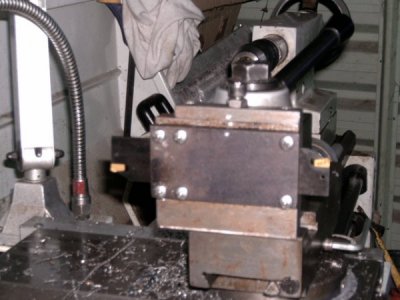- Joined
- Oct 21, 2017
- Messages
- 504
Rear tool post parting with an inverted cutter solves some issues encountered with conventional tooling, but no one has mentioned the major issues.
1. A badly adjusted or poorly designed/built spindle with insufficient rigidity or too much sideways free movement can be pushed away by the tool, once the tool is cutting, the work can climb up and into the cutter and the instantaneous increase in tool engagement ends badly as the tool is effectively wedged between opposing forces from bed and work.
2. If a slide has excess backlash then when cutting commences the forces can take up that backlash and that's a short but quick move into the work which, once again, ends badly.
Both of these situations will be made worse by a cutter being set slightly low which will increase the tendency to pull the cutter into the work or being slightly off from 90 degrees to the work axis in X or Y as the resulting friction on the sides of the cut will increase forces on the tool, as will inappropriate feeds and speeds or the lack of cutting fluid where needed.
When I first bought my Myford Super 7 lathe I though there must be a magic parting tool somewhere that would solve all my problems, over time I found that I no longer had any issues parting any materials and all the parting tools I bought which didn't work before, with proper set up and use, now work fine, I have an inverted parting tool for the rear tool post but this is used simply for convenience and speed when making washers, bushes or other quick jobs where it gives me an extra tool without a tool change and without the need to reverse,
- Nick
1. A badly adjusted or poorly designed/built spindle with insufficient rigidity or too much sideways free movement can be pushed away by the tool, once the tool is cutting, the work can climb up and into the cutter and the instantaneous increase in tool engagement ends badly as the tool is effectively wedged between opposing forces from bed and work.
2. If a slide has excess backlash then when cutting commences the forces can take up that backlash and that's a short but quick move into the work which, once again, ends badly.
Both of these situations will be made worse by a cutter being set slightly low which will increase the tendency to pull the cutter into the work or being slightly off from 90 degrees to the work axis in X or Y as the resulting friction on the sides of the cut will increase forces on the tool, as will inappropriate feeds and speeds or the lack of cutting fluid where needed.
When I first bought my Myford Super 7 lathe I though there must be a magic parting tool somewhere that would solve all my problems, over time I found that I no longer had any issues parting any materials and all the parting tools I bought which didn't work before, with proper set up and use, now work fine, I have an inverted parting tool for the rear tool post but this is used simply for convenience and speed when making washers, bushes or other quick jobs where it gives me an extra tool without a tool change and without the need to reverse,
- Nick
Last edited:


